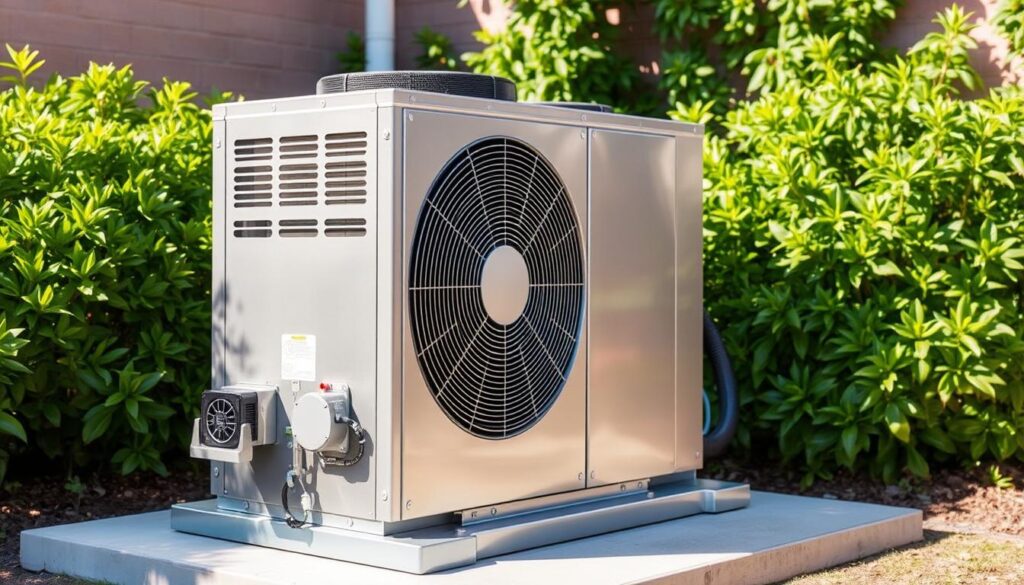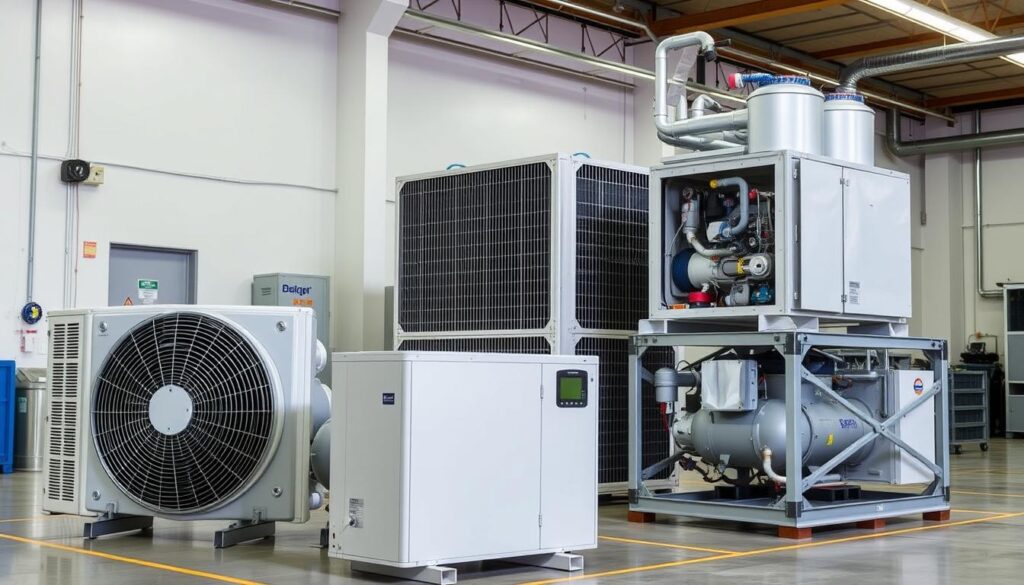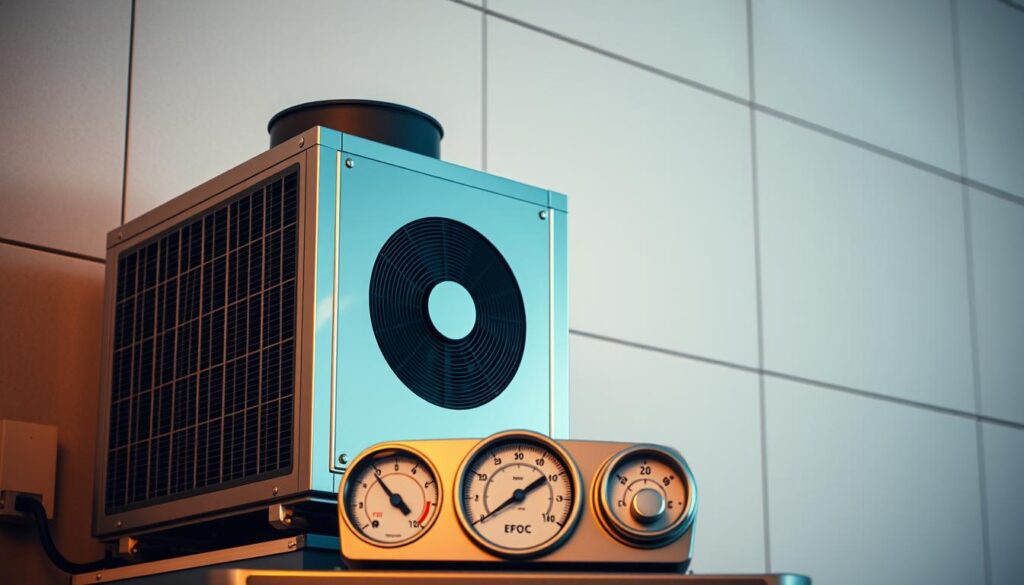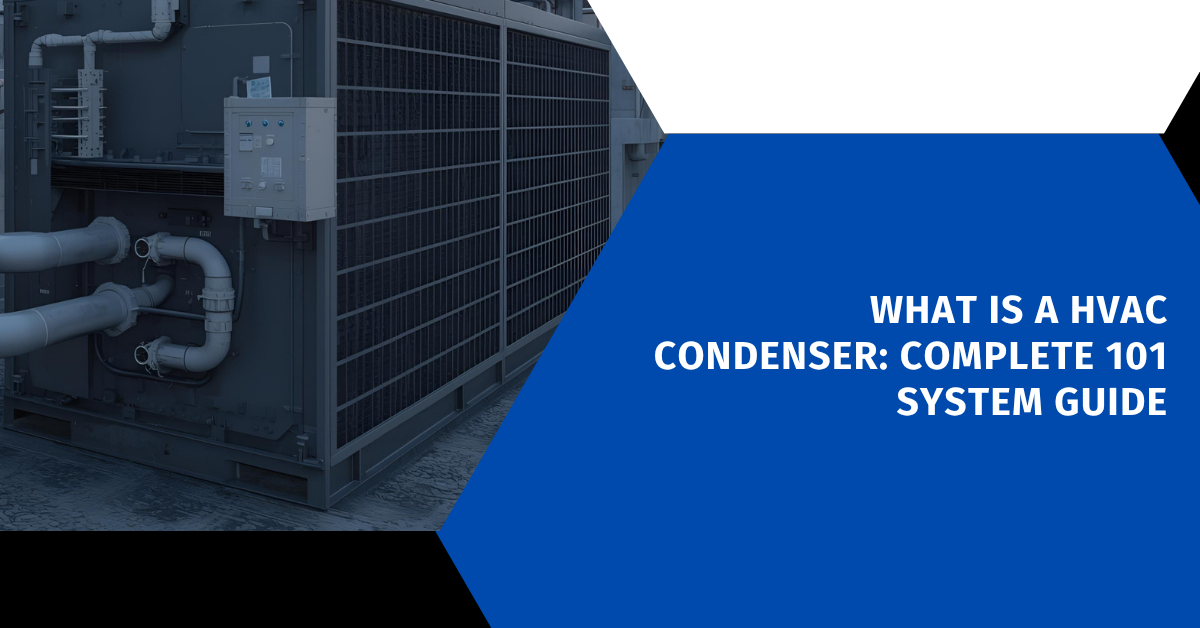Affiliate Disclosure
HVAC Guide Guys is a participant in the Amazon Services LLC Associates Program, an affiliate advertising program designed to provide a means for sites to earn advertising fees by advertising and linking to Amazon.
What Is a HVAC Condenser? Ever wondered how your home stays cool on hot summer days? The secret is in your air conditioning system’s heart: the HVAC condenser. It turns your indoor comfort into a cool reality.

The air conditioning condenser unit is your home’s outdoor cooling hero. It’s key in moving heat from inside to outside. When it’s hot, your HVAC condenser keeps your home cool and comfy.
Learning about HVAC condensers shows the amazing tech behind your home’s temperature control. This guide will explain their key functions, parts, and how they work.
Key Takeaways
- HVAC condensers are critical for heat transfer in cooling systems
- The unit is typically located outside your home
- Condensers work by releasing heat collected from indoor spaces
- Regular maintenance ensures optimal performance
- Understanding your condenser can help improve energy efficiency
Table of Contents
What Is a HVAC Condenser
An HVAC condenser is a key part of your home’s cooling system. It removes heat from your living space. This part of the central air condenser works hard to keep you cool during hot summer months.
Basic Functions and Purpose
The main job of the HVAC condenser is to change refrigerant from gas to liquid. It does this by releasing heat. This change is key for cooling your home.
Your HVAC system needs this part to:
- Remove heat from indoor air
- Convert refrigerant from gaseous to liquid state
- Prepare refrigerant for the next cooling cycle
Role in Your HVAC System
The condenser unit is outside your home. It works with other parts to control indoor temperature. It has important elements:
| Component | Function |
|---|---|
| Compressor | Pressurizes refrigerant |
| Condenser Coil | Releases heat from refrigerant |
| Fan | Helps dissipate heat quickly |
Common Applications
Central air condensers are used in many places. These units adapt to different cooling needs. They work well in:
- Single-family homes
- Apartment complexes
- Office buildings
- Retail spaces
Knowing about your HVAC condenser helps you understand how it keeps your space cool and comfy.
Explore Our HVAC Shop
Looking for top-rated HVAC tools, parts, and accessories? Visit our shop and find the perfect solution for your needs.
Visit the ShopEssential Components of an HVAC Condenser Unit
Your outdoor HVAC unit is a complex system with several critical parts. These parts work together to keep your home cool. Knowing about these components can help you take better care of your cooling system.
- Compressor: The heart of the cooling system that pressurizes and moves refrigerant
- Condenser Coil: Releases heat from the refrigerant to the outside environment
- Condenser Fan: Helps dissipate heat by blowing air across the condenser coils
- Refrigerant Lines: Copper tubes that transport refrigerant between indoor and outdoor units
Each part is key to the cooling process. The compressor is like a pump, moving refrigerant and creating pressure. The condenser coil turns high-pressure gas into liquid, releasing heat.
Other important parts include:
- Pressure switches for system protection
- Electrical controls and capacitors
- Protective metal housing
- Vibration dampeners
When all these parts work together, your outdoor HVAC unit efficiently cools your home. This makes your indoor temperatures cool and comfortable.
Understanding the Condenser Working Process
Your HVAC system uses a cool process to keep your home comfy. The condenser is key in removing heat and keeping temperatures right.
The condenser unit changes hot, high-pressure gas into cool liquid. This change is vital for your AC to cool your home well.
Heat Transfer Mechanism
The heat transfer process is important for your AC’s upkeep. It involves several steps:
- Hot refrigerant gas enters the condenser coils
- Exterior fan blows ambient air across the coils
- Heat is dissipated from the refrigerant to the surrounding air
- Refrigerant transitions from gas to liquid state
Refrigerant Cycle
Knowing the refrigerant cycle shows how efficient your HVAC system is. It involves constant changes that help remove heat:
| Stage | Process | State Change |
|---|---|---|
| Compression | Refrigerant compressed | Gas, high pressure |
| Condensation | Heat released to exterior | Liquid formation |
| Expansion | Pressure reduction | Liquid to low-pressure gas |
| Evaporation | Heat absorption | Cooling effect created |
Temperature Control Process
Your HVAC system controls temperature by managing refrigerant pressure and state. Proper condenser function ensures consistent cooling performance and energy efficiency in your home.
Explore Our HVAC Shop
Looking for top-rated HVAC tools, parts, and accessories? Visit our shop and find the perfect solution for your needs.
Visit the ShopTypes of HVAC Condensers in Modern Systems
Your HVAC system uses different condensers to keep your home comfy. The heat pump condenser and central air condenser are key. They help cool and heat your space.

Today’s HVAC systems have various condenser types. Each has its own features:
- Air-Cooled Condensers: Common in homes, they use outside air to cool
- Water-Cooled Condensers: Found in big commercial buildings
- Evaporative Condensers: Use water and air to cool
Split air conditioners and heat pump condensers have similar parts. But, they work differently. A heat pump can cool and heat your home. A central air condenser mainly cools it.
“Choosing the right condenser can significantly impact your home’s energy efficiency and comfort.” – HVAC Engineering Professionals
New tech like microchannel condensers is changing HVAC. They improve heat transfer, are smaller, and use less energy. They’re the future of keeping your home at the right temperature.
When picking a condenser, think about your climate, building size, and energy goals. Your needs will help decide between a heat pump or a central air condenser.
The Role of Refrigerants in Condenser Operation
Refrigerants are key to any refrigerant condensing system. They help your HVAC system cool your space. These special chemicals make heat transfer possible.
Knowing about refrigerants shows how complex your cooling system is. They change from liquid to gas to move heat around.
Common Refrigerant Types
Today’s HVAC systems use different refrigerants. Each has its own special features:
- R410A: The go-to for most homes
- R134 Hydrofluorocarbons (HFCs): Being replaced
- R-32: A new, green choice
Environmental Considerations
The HVAC world is getting greener. Old refrigerants like R-22 are being swapped for greener ones. These new ones have less harm to the planet.
Safety Measures
Working with refrigerants needs a pro. Always choose certified HVAC techs. They know:
- How to handle refrigerants safely
- How to dispose of them right
- The dangers to the environment
Keeping your cooling system and the planet safe starts with knowing refrigerants.
Installation Requirements and Considerations
Installing a central air condenser needs careful planning and expert help. Your outdoor HVAC unit is key to your home’s cooling. It must be placed and set up just right for the best performance.
When getting ready for installation, pay attention to a few important things:
- Choosing the right spot for the outdoor hvac unit
- Making sure it’s far enough from other structures
- Ensuring the foundation is level
- Meeting electrical connection needs
Finding the perfect spot for your central air condenser is important. Look for a place that:
- Allows good airflow around the unit
- Keeps it away from direct sunlight and harsh weather
- Reduces noise
- Makes it easy to get to for upkeep
“Proper installation is the foundation of an efficient HVAC system.” – HVAC Professional Recommendation
Getting a pro to install is key because of the technical details. Refrigerant charging, electrical connections, and precise calibration are not jobs for amateurs. Experts know exactly what your outdoor hvac unit needs.
The size of your central air condenser is also very important. The wrong size can cause:
- More energy use
- Less cooling power
- Sooner wear and tear
- Unstable home temperatures
By choosing professional installation and knowing these key points, you’ll get the most out of your HVAC system.
Explore Our HVAC Shop
Looking for top-rated HVAC tools, parts, and accessories? Visit our shop and find the perfect solution for your needs.
Visit the ShopMaintenance and Care of Your Condenser Unit
Keeping your HVAC condenser in good shape is key for its best performance. Regular care helps avoid expensive repairs and keeps your cooling system efficient all year.
To keep your condenser unit running well, mix DIY care with professional services. A smart approach to condenser coil maintenance boosts your system’s performance greatly.
Key Regular Maintenance Tasks
- Clear debris from around the outdoor unit regularly
- Inspect and clean condenser coils at least twice a year
- Check and replace air filters every 1-3 months
- Ensure proper clearance around the unit (at least 2 feet)
- Remove any vegetation or obstacles near the condenser
Professional Service Recommendations
Annual AC condenser replacement and professional maintenance are a must. A pro can:
- Do detailed system checks
- Check refrigerant levels
- Lubricate moving parts
- Inspect electrical connections
- Verify system efficiency
Quick Troubleshooting Guide
Watch for these warning signs that may indicate your condenser needs attention:
- Unusual noises during operation
- Reduced cooling efficiency
- Visible frost or ice buildup
- Increased energy consumption
If you’re unsure, always get help from a professional HVAC technician. Regular maintenance can prevent sudden breakdowns and costly ac condenser replacements.
Energy Efficiency and Performance Optimization

To get the most out of your HVAC condenser, you need a good plan and regular upkeep. How well your cooling system works affects how much energy it uses and how comfy your home is.
Here are some ways to make your HVAC cooling parts work better:
- Regular maintenance of condenser coils
- Checking and maintaining proper refrigerant levels
- Installing smart temperature controls
- Using variable-speed compressor technologies
Smart HVAC technologies can cut your energy use by up to 30% if done right.
| Optimization Strategy | Energy Savings | Implementation Difficulty |
|---|---|---|
| Clean Condenser Coils | 10-15% | Low |
| Smart Thermostat Installation | 15-20% | Medium |
| Variable-Speed Compressor | 25-30% | High |
“Efficient HVAC systems are not just about saving money, but also about reducing environmental impact.” – Energy Conservation Expert
Understanding your HVAC system’s needs is key to its performance. Think about getting a pro to check it out and find ways to improve it for your home’s cooling.
Explore Our HVAC Shop
Looking for top-rated HVAC tools, parts, and accessories? Visit our shop and find the perfect solution for your needs.
Visit the ShopCommon Problems and Solutions
Your HVAC condenser can face several big issues. These problems can hurt its performance and efficiency. Spotting these early can help avoid expensive repairs and replacements.
Homeowners often run into a few common HVAC problems. These include:
- Refrigerant leaks that cut down cooling power
- Electrical part failures
- Compressor issues
- Dirty or damaged condenser coils
Refrigerant leaks are a big problem. They can happen due to damage, corrosion, or old connections. Look out for signs like less cooling and frost on refrigerant lines. Experts can find and fix leaks during regular maintenance.
Electrical problems can cause your system to cycle on and off or shut down. These issues might come from:
- Bad capacitors
- Damaged wiring
- Tripped circuit breakers
- Worn-out contactors
Compressor failures are a big deal. If your compressor stops working, it usually needs to be replaced. Regular maintenance can help avoid sudden failures.
Regular checks and care are essential for your HVAC system’s health and performance.
To avoid problems, get annual professional maintenance. Also, do regular checks on your condenser unit. Clean around it, remove debris, and make sure air can flow well to keep your system running smoothly.
Conclusion
Knowing what a HVAC condenser is key to a comfy home. Your air conditioning unit is essential for cooling and keeping temperatures right. Learning about it helps you make better choices for your home’s climate.
Keeping your HVAC in top shape is more than just basic upkeep. Regular checks by pros and knowing your unit well can avoid big repair bills. It also boosts energy use. You’ll save money and keep your cooling system running longer by being proactive and informed.
Now you know more about HVAC condensers, you can make smarter choices as a homeowner. Whether it’s routine care or thinking about upgrades, your knowledge helps. Always turn to HVAC experts for detailed care and solving technical issues.
Controlling your home’s climate starts with knowing its parts. Learning about HVAC condensers can lead to better comfort, lower energy bills, and a more efficient cooling system. Use this knowledge to improve your HVAC’s performance.

